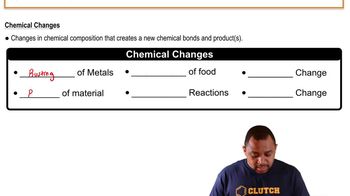Here are the essential concepts you must grasp in order to answer the question correctly.
Gibbs Free Energy
Gibbs Free Energy (G) is a thermodynamic potential that helps predict the spontaneity of a process at constant temperature and pressure. A reaction is spontaneous if the change in Gibbs Free Energy (∆G) is negative. The relationship between enthalpy (∆H), entropy (∆S), and temperature (T) is given by the equation ∆G = ∆H - T∆S, where a negative ∆H and a positive ∆S favor spontaneity.
Recommended video:
Gibbs Free Energy (Simplified) Concept 3
Enthalpy Change
Enthalpy change (∆H) refers to the heat absorbed or released during a chemical reaction at constant pressure. In the given reaction, ∆H is negative (-43 kcal/mol), indicating that the reaction is exothermic, meaning it releases heat. Exothermic reactions tend to be more favorable for spontaneity, especially at lower temperatures, as they contribute to a decrease in Gibbs Free Energy.
Recommended video:
Physical & Chemical Changes
Entropy
Entropy (S) is a measure of the disorder or randomness in a system. In the context of spontaneity, an increase in entropy (positive ∆S) generally favors a reaction being spontaneous. For the reaction provided, understanding how the formation of solid HgO from liquid Hg and gaseous O2 affects the overall entropy is crucial, as a decrease in entropy could counteract the favorable enthalpy change.
Recommended video:
Entropy (Simplified) Concept 1
 Verified Solution
Verified Solution



 0:46m
0:46m
